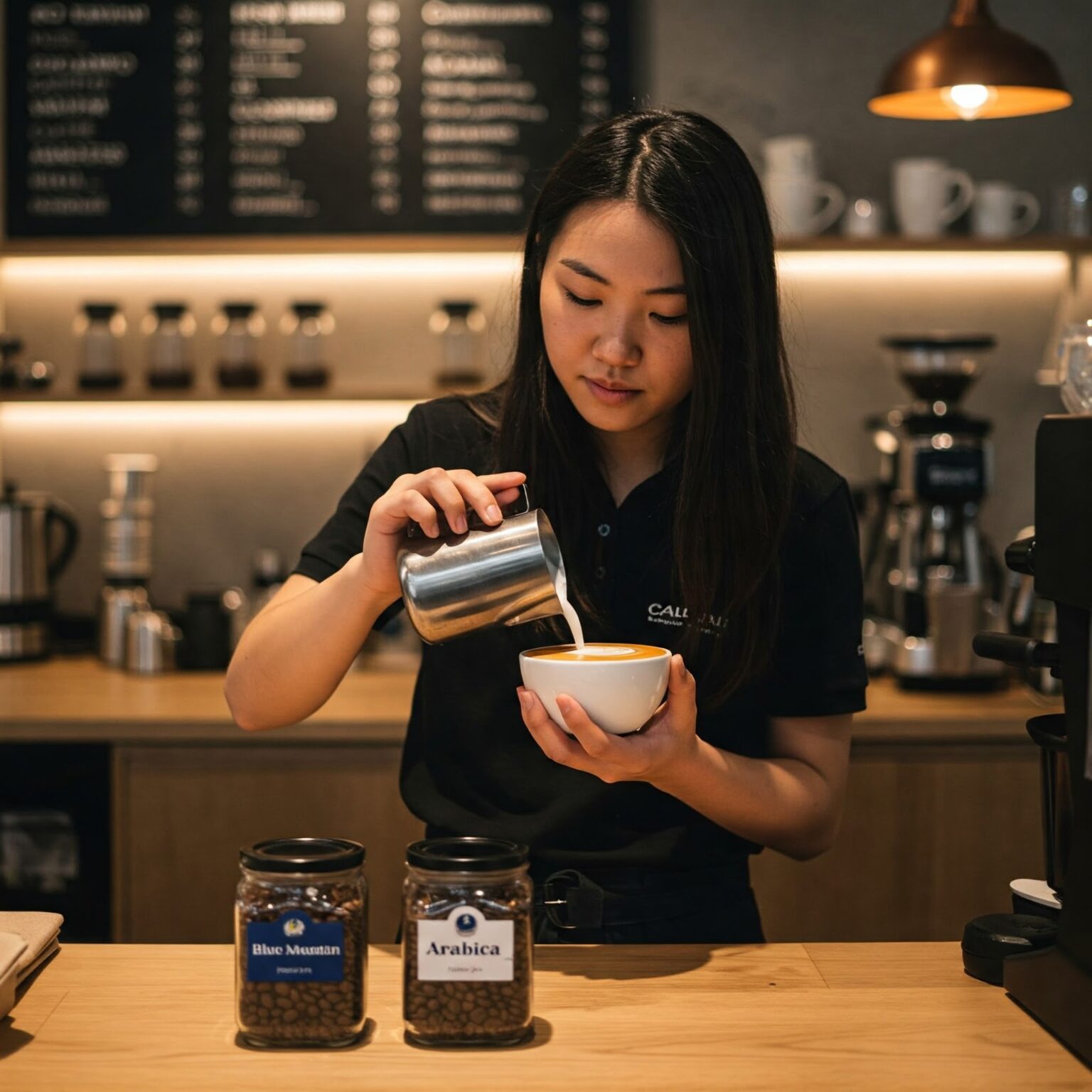Checking Out the Abundant Tastes of Coffee Beans: a Deep Dive Into Coffee and Blended Coffee Beans
When you discover the abundant tastes of coffee beans, you discover a complicated world where each variety brings its very own personality to your mug. As you navigate with the art of coffee and the creativity behind mixed coffees, you'll start to appreciate the nuances that make each sip one-of-a-kind.
The Beginnings of Coffee Beans: Exploring Terroir and Flavor Profiles
When you take a sip of coffee, you're not simply appreciating a beverage; you're experiencing a rich tapestry of tastes shaped by the beans' beginnings. Each region generates distinct taste profiles affected by dirt, elevation, and climate. For circumstances, beans from Ethiopia typically burst with intense, fruity notes, while those from Colombia often tend to use a well balanced, nutty sweetness.
As you explore different origins, you'll discover how terroir-- the ecological elements impacting a crop-- plays a vital role - Single Origin Espresso. The very same coffee selection can taste significantly different depending upon where it's expanded
When you think about these aspects, you begin to appreciate the complexity behind your cup. Each sip informs a story of the land and the farmers that supported the beans. Following time you indulge, believe regarding the journey your coffee took prior to it reached your hands, and appreciate those elaborate tastes that reflect its beginning.
Recognizing Coffee: The Art and Science Behind the Brew
When you consider coffee, it's not nearly the solid taste; it's additionally concerning the methods that bring it to life. Recognizing exactly how different preparation methods impact preference can change your developing experience. Let's explore the complexities of espresso preparation and reveal the one-of-a-kind taste profiles that make each cup unique.
Coffee Preparation Techniques
Coffee prep work is both an art and a scientific research, combining precise strategies with a deep understanding of coffee. To begin, you'll intend to choose top quality, freshly baked beans and grind them finely for perfect extraction (Single Origin Espresso). The work size is essential; as well rugged, and your coffee will certainly be weak, also great, and it'll be bitter
Next, tamp the premises uniformly in the portafilter to guarantee consistent extraction. When you secure it into the machine, go for a developing temperature in between 190 ° F and 205 °
F.As you pull the shot, expect the best extraction time-- around 25-30 secs. The result must be a rich, luscious espresso with a lovely layer of crema on top. With technique, you'll grasp these techniques.
Taste Profiles Described
The globe of espresso provides an abundant tapestry of flavor profiles that can raise your coffee experience. When you take that very first sip, you'll observe a balance of bitterness, sweet taste, and level of acidity. Each coffee bean carries special notes, from fruity and flower to nutty and chocolaty. Light roasts usually display brilliant level of acidity and vibrant flavors, while dark roasts present deeper, bolder tones.
Recognizing these accounts aids you pick the appropriate coffee for your taste. Experimenting with different blends can reveal surprising combinations. For instance, a well-crafted blend might harmonize the bright notes of an Ethiopian bean with the abundant, chocolatey undertones of a Brazilian bean. Embrace the journey of finding coffee's varied tastes, and you'll change your coffee routine into an interesting adventure.
Handling Techniques: Exactly How They Influence Taste and Fragrance
While it may seem that the origin of coffee beans is the most substantial consider establishing their taste and scent, the processing methods used post-harvest play a just as important role. You'll locate that these approaches can dramatically modify the last taste account of your mug.
As an example, the washed process gets rid of the fruit from the beans before fermentation, typically resulting in a cleaner, brighter flavor. Meanwhile, the all-natural procedure leaves the fruit intact throughout drying, resulting in a sweeter, fruitier profile.
Other techniques, like honey processing, strike an equilibrium, enabling some fruit mucilage to remain, offering a distinct complexity.
Each handling technique engages with the beans' fundamental characteristics, boosting or muting details flavors and aromas. So, when you drink that espresso or combined coffee, bear in mind that the trip from cherry to cup is influenced not simply by origin however additionally by how those beans were refined.
Roasting Strategies: Opening the Full Prospective of Coffee Beans
Roasting strategies are vital for disclosing the full capacity of coffee beans, as they change raw, green beans into the fragrant, flavorful coffee you take pleasure in. The selection of home roasting technique-- light, medium, or dark-- significantly influences taste accounts. Light roasts preserve the beans' natural level of acidity and fruity notes, while tool roasts equilibrium sweetness and richness. Dark roasts, on the various other hand, stress bold, smoky flavors.
You can explore roasting times and temperature levels to locate your perfect mixture. A slower roast at reduced temperature levels permits for intricate tastes to develop, while a quicker roast can heighten resentment. Pay interest to the splits throughout toasting; the initial crack suggests a light roast, while the 2nd split signals a dark roast. By mastering these techniques, you'll expose a globe of taste, elevating your coffee experience to brand-new elevations. Take pleasure in every sip, understanding the care that went into your mug!
The Magic of Blended Coffee: Producing Unique Taste Experiences
Producing a special flavor experience with combined coffee can change your morning routine into an exploration of preference. By integrating different beans from numerous regions, you can reveal a harmony of flavors that elevate your mug to new elevations. Each blend deals an unique profile, stabilizing sweet taste, body, and level of acidity to create something absolutely unique.
When you choose a mix, you're not simply choosing a coffee; you're choosing a journey across diverse landscapes and societies. Try out different mixes permits you to find your personal faves, whether you delight in fruity notes or abundant, chocolatey undertones.

Sampling Notes: Recognizing the Nuances in Your Mug
As you drink your coffee, you might observe a range of flavors dancing on your taste buds, each disclosing the ins and outs of the beans. You might taste the bright level of acidity evocative citrus or the deep, rich notes similar to dark delicious chocolate. The sweet taste could evoke honey or sugar, stabilizing the total profile magnificently.
Focus on the body of the coffee-- does it feel light and ventilated, or is it complete and creamy? The finish, as well, provides clues; a remaining aftertaste might hint at nuttiness or flower undertones.

Do not neglect to check out the special attributes of various origins, as each region imparts distinct flavors - Single Origin Espresso. Ethiopian coffees often existing fruity notes, while Colombian beans could showcase a more rounded sweet taste. By identifying these nuances, you'll strengthen your recognition for every mug, boosting your coffee experience to brand-new heights

Brewing Methods: Taking Full Advantage Of Taste Extraction for each Bean
When you discover the numerous developing techniques, you'll uncover that each technique can substantially influence the flavor account of your coffee. From French press to pour-over, each approach removes various substances, improving or muting specific notes. Using a French press permits oils to remain in the mixture, producing a richer taste, while pour-over stresses clarity and illumination.
Temperature and grind dimension likewise play important duties. A coarser grind functions best for chilly mixtures, while a great work is excellent for coffee. Explore water temperature level-- in between 195 ° F and 205 ° F-- can reveal surprise flavors, too.
Don't forget regarding steeping time; a fast extraction can bring about sour notes, while over-extraction might yield resentment. By adjusting these variables, you can take full advantage of flavor removal and truly raise your coffee experience. Appreciate the journey of finding what approach best fits your taste!
Frequently Asked Concerns
What Is the Perfect Water Temperature for Brewing Coffee?
The suitable water temperature for developing coffee's between 195 ° F and 205 ° F. If you utilize water that's too warm, you'll over-extract tastes; also chilly, and you will not extract enough. Go for that pleasant place for the best mixture!
Exactly How Does Work Dimension Impact Coffee Taste?
Work dimension substantially influences coffee flavor. Better grinds remove much more flavors and oils, causing a bolder taste, while coarser grinds yield a lighter taste. Readjusting work dimension assists you achieve your preferred coffee profile.
Exist Health Advantages Associated With Drinking Coffee?

What Is the Difference In Between Arabica and Robusta Beans?
Arabica beans are smoother and sweeter, often including fruity tastes, while robusta beans are more powerful with a bitter taste and higher high levels of caffeine content. You'll notice these distinctions in fragrance and developing experience.
How Can I Store Coffee Beans for Quality?
To save coffee beans for quality, keep them in an airtight container, far from light, warmth, and dampness. If you just grind what you require right before brewing., you'll maintain their taste much longer.
Checking Out the Abundant Flavors of Coffee Beans: a Deep Dive Into Coffee and Blended Coffee Beans.
When you discover the abundant tastes of coffee beans, you discover a complicated world where each variety brings its own personality to your cup.When you take a sip of coffee, you're not simply appreciating a beverage; you're experiencing an abundant tapestry of flavors shaped by the beans' beginnings.Roasting methods are vital for revealing the complete capacity Related Site of coffee beans, as they transform raw, green beans right into the aromatic, savory coffee you delight in.As you drink your coffee, you may see a spectrum of tastes dancing on your palate, each exposing the intricacies of the beans.